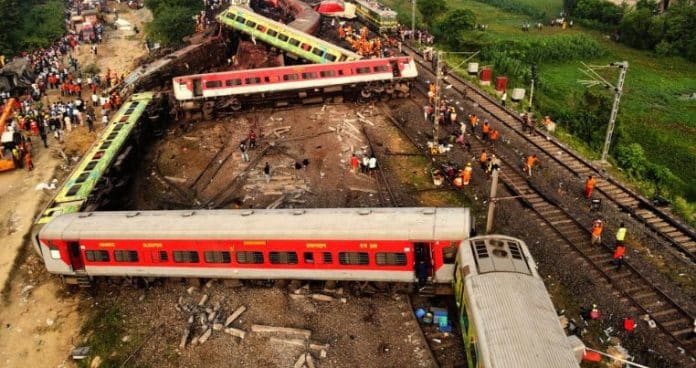The horrific train crash, claiming a place among the deadliest in India’s history, has sent shockwaves of sorrow and despair through the entire nation. Early investigations have suggested that a “signal fault” may have led to the tragedy in Odisha, Eastern India. The collision involved two express passenger trains and a freight train.
Earlier reports stated that the accident claimed the lives of at least 288 people and injured over 800. However, the numbers have been revised to 275 deaths and 1175 wounded, after some bodies were counted twice.
Available Details about Train Disaster in India
Indian Railway Minister, Ashwini Vaishnaw, has said that a signal fault, possibly due to a “change in electronic interlocking,” is the likely cause of the deadly three-train collision in Odisha. The minister also said that the responsible individuals have been identified but did not provide further details. Further inquiry will reveal whether the cause was manual, incidental, weather-related, due to wear and tear, or a maintenance failure.
India’s Railway Board also confirmed that a presence of “some kind of signaling interference” but has dismissed the notion of a system failure. The electronic interlocking system, responsible for setting routes for trains in a specific area to ensure safe movement, is reportedly working fine. Investigations are ongoing to determine the exact nature of the accident.
Meanwhile, concerned citizens have been raising their voice on social media regarding the poor health and safety protocols of Indian railway network.
https://twitter.com/OdishaDonToka/status/1665391918899945473
How Did the Crash Happen?
According to reports, the collision occurred when a passenger train was directed onto a loop track by the side of the main line, colliding with a stationary goods train before derailing. The derailed carriages then struck the rear carriages of a second passenger train traveling in the opposite direction. Both passenger trains had approached a Balasore district station under a green signal, indicating safety, within seconds of each other at the correct speed. Social media users shared a video demonstration of the mishap.
https://twitter.com/SnehashishPaul7/status/1665325283262472193
The collision has caused concerns that it should not have been possible for green signals to display on the main line if the track was set for the loop. Signal interlocking is supposed to be failsafe to avoid exactly these kind of accidents. It has raised more questions regarding the railway safety in India, as it struggles to make sufficient improvements.
One of the world’s largest railway network carries millions of passengers on daily basis. A government railway safety report revealed that derailments accounted for 70% of railway accidents, with track defects being a significant contributing factor. Regular track maintenance, including inspections and repairs, is essential to prevent such incidents.
Sad History of Railway Accidents in India
Indian railway infrastructure, despite its extensive reach and historical significance, is plagued by numerous shortcomings and deficiencies that hinder its effectiveness and compromise passenger safety. Despite ongoing upgrades and expansion efforts, derailments are one of many areas of concern that demand immediate attention and substantial improvements.
In last 5 years, there are 3 major train accidents that have raised these same issues. On October 19, 2018, a train ran over people gathered on railway tracks to watch Dussehra celebrations near Amritsar in Punjab. The accident resulted in the death of over 60 people while injuring countless others. On November 20, 2016, 14 coaches of the Indore-Patna Express derailed near Kanpur in Uttar Pradesh. The accident killed 150 people and injured more than 200.
Why Do Trains Crash So Often in India?
One of the most common and glaring issues in these crashes is the outdated and overburdened tracks. Many sections of the railway network have not seen upgrades in years, leading to frequent track defects and failures. The lack of proper maintenance and modernization exacerbates the risk of derailments and accidents, posing a constant threat to the lives of passengers.
Furthermore, the overcrowding issue on Indian trains is a persistent and distressing problem. Passengers are crammed into trains like sardines, often surpassing the recommended capacity. This not only compromises comfort but also compromises safety, making evacuation difficult in the event of an emergency. The authorities’ failure to address this issue adequately showcases a disregard for passenger well-being and an alarming lack of long-term planning.
The communication and signaling systems employed by Indian Railways also leave much to be desired. Frequent signal failures and disruptions are a common occurrence, causing delays and chaos for passengers. The absence of a reliable and efficient signaling infrastructure not only inconveniences travelers but also increases the risk of accidents due to miscommunications or human errors.
Moreover, the absence of advanced safety features and technology is a significant concern. While some progress has been made in installing anti-collision devices on select routes, the overall implementation remains inadequate. Lack of comprehensive safety measures, such as automated train control systems, increases the vulnerability of the system to human error and technical failures.
Lack of Commitment and Accountability
The maintenance practices and inspection procedures within the Indian Railways system are riddled with inefficiencies. Reports of inadequate inspections and lax oversight highlight a lack of commitment to ensuring the structural integrity of tracks, coaches, and engines. Insufficient monitoring and preventive maintenance contribute to the persistently high number of accidents and derailments.
The overall lack of accountability within the railway infrastructure is deeply troubling. Instances of corruption and mismanagement are prevalent, leading to substandard construction, compromised safety standards, and rampant negligence. The absence of a transparent and robust accountability mechanism undermines public trust in the system and impedes progress in addressing critical issues.


